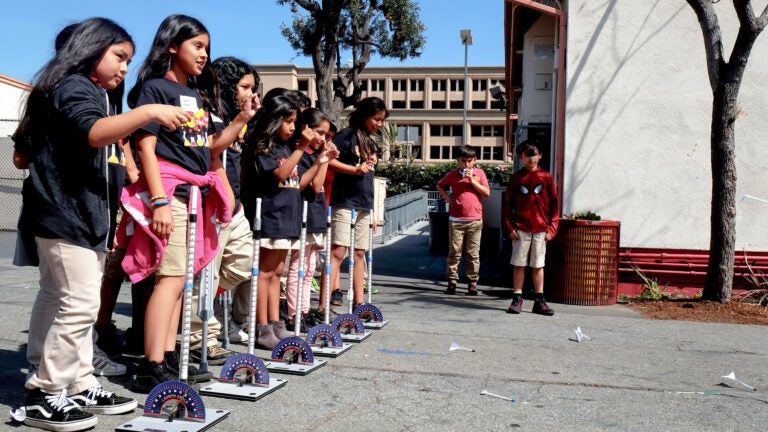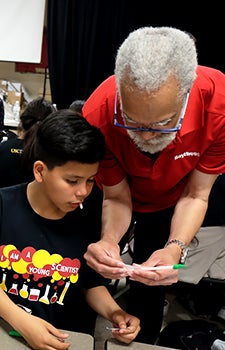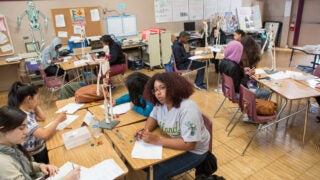
Rocket science, aerospace attract kids to USC’s young scientists workshop
Vermont Elementary School students test their designs of straw rockets and build models of hoverboards
Faces lit up in anticipation, fourth- and fifth-grade students ran onto the playground at Vermont Elementary School near USC’s University Park Campus.
Clutched in their hands were the straw rockets they had built during a Young Scientists Program’s aerospace and engineering workshop held in the school auditorium. Excitement grew as the kids formed lines behind six Pitsco straw rocket launchers stationed in the schoolyard.
The devices, lent by Raytheon, a partner on the workshop, use pneumatic force to launch the rockets, allowing the students to test their design and conduct experiments by varying the trajectory angle and launch energy. Raytheon is a technology company that specializes in defense, civil government and cybersecurity solutions.
The workshop gave the students insight into the ways engineers think and the idea that failure can be a good thing, said Dieuwertje “DJ” Kast, the STEM program manager for the Joint Educational Project based at the USC Dornsife College of Letters, Arts and Sciences.
“As an engineer, often you’re trying to figure out why something isn’t working,” she said. “It helps you make a prototype, test it, redesign it and test it again. It’s a cycle of getting to your perfect design.”
Rocket science for kids: light sabers and hoverboards

The workshop kicked off with a talk by Jeffrey Tate, a senior engineering fellow at Raytheon who said he became interested in math and science when he was 12, thanks to Star Trek and the encouragement of his teachers.
Tate, who as an African-American belongs to an underrepresented group in the science, technology, engineering and mathematics fields, provided a relatable role model for the students, nearly all of whom are of color. He wielded light sabers to demonstrate how engineers use their creativity.
One of the central points of his presentation was that all people are capable of great ideas and making them a reality.
“I tell the kids that somebody had an idea because they were inspired by Star Wars and they came up with a model, built it and were able to make it work,” he said. “And then I pull out the light sabers — a toy that required someone to do some engineering in order to make it work.”
Tate, who was introduced as an engineer and a rocket scientist, brought his own drone and some science fair projects from his own childhood. He explained how those projects sparked his interest in science as a kid and told the students that he was there to do the same for them now.
Fifth-grade teacher Krystal Kim was delighted that 10 of her students signed up for the workshop.
“We don’t spend a lot of time in the classroom teaching science,” she said, “so this is great way for them to get hands-on with real scientists.”
At the workshop, students also built a miniature model of a hoverboard out of a CD, a Gatorade cap and a balloon, and several lucky pupils rode on a full-size Raytheon hoverboard made with a leaf-blower engine.
Fourth-grade student Oscar Morales said he’s part of the Young Scientists Program because of his love of science.
“I have always wanted to be a scientist when I grow up,” he said, “and this is great training for when I become an adult.”
Sparking an interest in STEM careers
Kast, who wore an astronaut-themed dress for the event, noted that all the workshops are designed to demonstrate potential STEM career possibilities.
I hope to ignite some type of STEM spark.
DJ Kast
“I really want the students to see that these are potential careers for them,” she said. “I hope to ignite some type of STEM spark and the knowledge that, whether it’s in engineering or in aerospace, there are possibilities for these students.”
Kast noted that participation in the Young Scientists Program is split evenly between the girls and boys, and she expressed enthusiasm at seeing so many girls sign up for the workshop.
“YSP develops a pipeline for them to stay interested in STEM,” she said. “I really hope that workshops like this continue to inspire them.”
During his presentation, Tate mentioned the Black Panther character Shuri as an example of an amazing engineer.
“This was a wonderful way to demonstrate to girls that there are examples out there whom they can look up to as potential role models, whether in a comic book or in real life,” Kast said.



